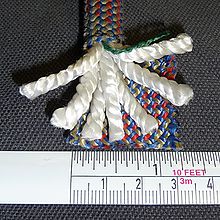- Kernmantle rope
-
Kernmantle rope is rope constructed with its interior core (the kern) protected with a woven exterior sheath (mantle) that is designed to optimize strength, durability, and flexibility. The core fibers provide the tensile strength of the rope, while the sheath protects the core from abrasion during use. The name is derived from German Kernmantel... which means coat protected core.
Contents
Use as climbing rope
The nylon ropes that were used in yachts for hauling were tested and found useful in climbing and caving, and are now the modern standard. Although there are occasional innovations, the type of rope used today is similar in construction, strength, and durability across manufacturers. There are several major manufacturers, including Pigeon Mountain Industries (PMI) which is popular with cavers,[1] Mammut, Sterling, Beal, Edelweiss, Blue Water, Roca, and Maxim. Kernmantle ropes are still used in sailing and other sports, however the technical requirements are usually not as rigorous as in climbing since those applications are not as safety critical. Smaller kernmantle ropes are commonly called accessory cord; they are often used to make prusik knots and loops or attaching accessories such as chalk bags.
One or more of the rope characteristics (strength, durability, and flexibility) are often altered somewhat, depending upon the ultimate use of the rope, at the expense of the other properties. For example, rope used in caving is generally exposed to more abrasion than other forms of recreation, so the mantle is woven more tightly than rope used in climbing or rappelling. However, the resulting rope is cumbersome and difficult to tie knots in.
Kernmantle construction may be used with both static and dynamic ropes. Static ropes are designed to allow relatively little stretch, which is most useful for hauling, rappelling, and other applications. Dynamic rope is used to belay climbers, and is designed to stretch under heavy load to absorb the shock of a fallen climber. Dynamic ropes manufactured for climbing are tested by the UIAA. This test involves tying an 80 kg weight to the end of a length of rope. This weight is then dropped 5m on 2.7m of rope with the rope running over a rounded surface simulating that of a standard carabiner. This process is repeated until the rope breaks. It is a common misunderstanding to think that the number of drop test falls (as conducted by the UIAA) is the number of real-life climbing falls a rope can sustain before it becomes unsafe. The drop test falls are of extreme severity and it is not often that a real-life climbing fall generates a comparable force. This adds a margin of safety for the climbers who use such ropes.
Rope care
 Parachute cord is a type of lightweight nylon kernmantle rope. The kern of this particular example is made up of seven two-ply yarns, the mantle is braided from 32 strands.
Parachute cord is a type of lightweight nylon kernmantle rope. The kern of this particular example is made up of seven two-ply yarns, the mantle is braided from 32 strands.
Kernmantle rope should be inspected before and after every use for any form of damage. "Boogers," which indicate internal damage to the kern, will appear as tufts of white threads poking out from the mantle. Ropes that have been severely stressed will have tapered sections to the rope, where it is visibly or palpably thinner. Rope that has been abraded or cut on sharp edges should be examined closely by an experienced user who may choose to cut the rope at that point, rather than risk it parting at that area.
Rope may be cleaned by forming it into a chain sinnet, to prevent excessive tangling, and washing it in a front-loading clothes washing machine with soap flakes. Strong cleansers, including bleach and detergent should not be used with life-critical Nylon components. Commercial rope cleaning devices are available from the climbing and rescue companies CMI and PMI.
Typical specifications
Dynamic Ropes Diameter Typical Impact Force* Typical Weight 8.1mm (~5/16") 6 kN (1350 lb) 42g/m (0.45oz/ft) 9.8mm (~3/8") 8 kN (1800 lb) 63g/m (0.67oz/ft) 11mm (~7/16") 9 kN (2000 lb) 78g/m (0.84oz/ft) *Dynamic ropes are rated for a certain number of falls (usually 5-10) at a given impact force.
Static Ropes Diameter Typical Breaking Strength Typical Weight 9mm (~11/32") 21 kN (4700 lb) 51g/m (0.55oz/ft) 10mm (~3/8") 27 kN (6000 lb) 66g/m (0.71oz/ft) 10.5mm (~13/32") 30 kN (6750 lb) 69g/m (0.74oz/ft) 11mm (~7/16") 34 kN (7650 lb) 75g/m (0.81oz/ft) See also
- Dynamic rope
- Fall factor
- Static rope
- Climbing equipment
- Sailing
References
- ^ Smith, Bruce; Allen Padgett (1996). On Rope; North American Vertical Rope Techniques (New Revised ed.). Huntsville, Ala.: National Speleological Society. p. 21. ISBN 1-879961-05-9.
Categories:- Caving equipment
- Climbing equipment
- Mountaineering equipment
Wikimedia Foundation. 2010.

